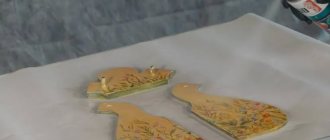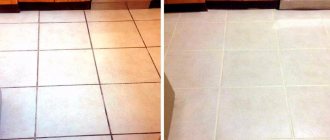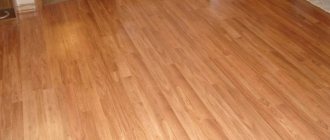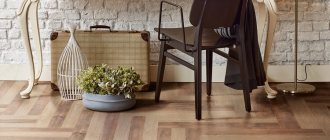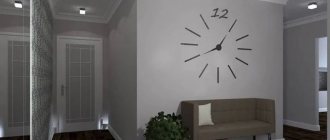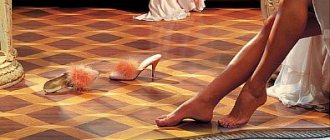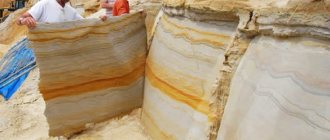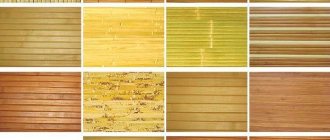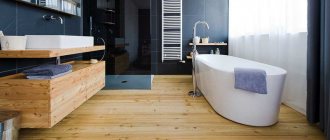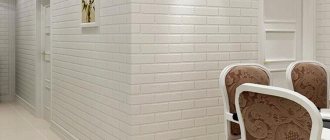The entrance hall is the first to greet guests. She is the face of the whole house, creating the mood and characterizing the owners. In addition to the fact that it should be cozy and beautiful, it is important to think about its practicality. When thinking about what the floor in the hallway will be like, you should take into account the features of this room and combine the aesthetic side with functionality. Nowadays, there are many types of flooring with different technical and visual characteristics. It won’t be difficult to choose one that suits your color, design and other requirements.
Option for flooring in the hallway.
No. 1. Linoleum
Linoleum has been and remains the most popular material for finishing the floor in the hallway. This is explained by its low cost along with a lot of positive qualities: moisture resistance, durability, ease of care, a huge variety of colors .
Linoleum can be one of the following types:
- synthetic linoleum is familiar to each of us, and this is what is meant in 99% of cases when they talk about linoleum. The main advantage is the widest choice of design; the material can imitate wood, tile or the seabed, and quite accurately. It is inexpensive, but dents from heavy furniture will remain, as well as black marks from shoes. For a hallway with heavy loads, you can choose semi-commercial or commercial linoleum – such material will last longer than household material;
- natural linoleum, or marmoleum. This coating is more natural and environmentally friendly than synthetic linoleum, as it is made from wood chips, resin, chalk, and linseed oil. The material is durable, has antibacterial and fire-fighting properties, but is more expensive than its artificial counterpart, and its installation process is more labor-intensive;
- piece linoleum, also called vinyl tile. It has all the same properties as synthetic linoleum, but with the help of individual squares you can lay out interesting designs, create a mosaic, and if something happens, replacing one damaged element will not be difficult. So, if somewhere the covering is torn or pressed under the influence of a furniture leg or heel, then only one square will have to be replaced, and the hallway will again have a neat appearance.
Peculiarities
The floor in the hallway comes into contact with street shoes and requires systematic wet cleaning. Therefore, in order to maintain its visual appeal for a long time, the coating must be water-repellent and wear-resistant.
Focusing on the technical characteristics, we must not forget that the floor is an integral part of the interior. He cannot stand out from the overall picture.
A floor that matches the interior perfectly.
Another criterion for choosing flooring for the hallway will be its price. If there is no detailed repair estimate, you will have to rely on the total amount allocated for all work so as not to exceed your financial capabilities.
No. 2. Ceramic tile
Ceramic tiles are another leader in the field of hallway floor finishing. The material has gained wide popularity due to a number of advantages that are invaluable in the hallway:
- high strength, wear resistance, moisture resistance, abrasion resistance;
- easy to maintain, resistant to various detergents;
- durability;
- environmental friendliness;
- a huge range of colors, patterns and sizes, so you can decorate the hallway in any style. In addition, tiles can imitate the surface of other materials.
Among the disadvantages of ceramic tiles, the only thing worth noting is that their surface is cold, but for a hallway this is not such a disadvantage. A more serious disadvantage is fragility. If a heavy object falls on the floor, there is a high probability that the tiles will be damaged.
It is worth noting that not just any tile is suitable for a hallway . So, you need to pay attention to strength, which is determined by classes from I to V. The most durable tiles of the V class are used in public spaces with a huge traffic of people, and for the hallway, material with strength III-IV is perfect. An important indicator will also be the resistance of the material to chemical influences: according to this indicator, tiles are divided into classes A, C and D. AA tiles are the most resistant to chemicals, but at the same time quite expensive, and AC class material is optimal for a hallway. And one more requirement for tiles in the hallway is the most non-slip surface, so it is better to pay attention to products with a matte or corrugated surface.
Types of flooring (selection of photographs for each option)
There are many different flooring options available on the market. Therefore, many buyers are confused about which flooring is best for the hallway of an apartment. The basic requirements for the material should be taken into account. It must be resistant to moisture and physical damage, practical, not dirty, and not harmful to the environment.
It is extremely important that all pollution from the street cannot leave the room.
Note! Recently there has been a trend towards the use of natural materials. You can easily find something beautiful and practical.
Tiles: tiles, porcelain tiles, natural stone and others
These materials are most often found when finishing floors. Porcelain tiles are highly resistant to sudden temperature changes and high humidity. This material is a tile that is processed in a special way.
Suitable for any design solution. You can choose different colors and textures.
Note! Porcelain tiles are quite expensive, so they are rarely used in apartments. Instead, it is better to use regular tiles.
The price range for this type of coverage is quite wide, so if you wish, you can choose a budget option or a more expensive one.
Natural stone looks natural and expensive. It is used quite rarely in apartments. Suitable for decorating country houses and estates. You can often find stones of natural shades on the market.
It is highly durable and can last for many years.
Ceramic tiles will be much cheaper. There are many different design options that are suitable for any interior design solution for an apartment. The tiles are quite cold, so the surface will need to be insulated.
It is particularly durable and is not afraid of mechanical and other damage.
Linoleum
If you don’t know what is best to put on the floor in the hallway, it is recommended to choose linoleum. Natural coating is practical, durable, but quite expensive.
This is a practical and inexpensive material that is suitable for rooms of any size.
Important! There are options with different patterns on the surface. Over time they may wear off. If you choose a low-quality material, dents may appear on the surface.
Piece natural parquet
It is a covering consisting of wooden boards. They are installed using various methods. The most common layout options are herringbone or geometric patterns. More complex options for laying parquet are possible.
This material looks great in any room in any area. In addition, you can choose any color palette and pattern.
Laminate
Consists of several layers. Wear-resistant and durable. The most common color choice is natural wood. The main disadvantage is that laying laminate flooring is not so easy. To prevent moisture from getting between the individual plates, a special grout is used.
It goes well with other materials. It is often installed in combination with ceramic tiles.
Carpet
Not the best solution for a corridor. Closer to the entrance, it is recommended to use more practical options that are not so vulnerable to adverse physical influences.
Carpet tiles are often used now. It's much easier to assemble.
Other options
One of the popular solutions is carpet runners. It looks expensive and beautiful. They differ from indoor options in their shorter pile length. They are easy to care for.
They are quite durable and widely used in everyday life.
No. 3. Porcelain tiles
This material has become widespread relatively recently, and today, based on all its indicators, it is considered a unique method of finishing floors. In most properties, porcelain stoneware resembles ceramic tiles, but the peculiarities of manufacturing technology make it possible to obtain an even more durable material, which is superior in characteristics to tiles and even stone.
The main advantages of porcelain stoneware are:
- high strength;
- resistance to abrasion, moisture and fire;
- durability;
- safety;
- ease of care;
- sufficient assortment. Porcelain tiles can imitate any other material, have any color and pattern, and the surface can be embossed.
Among the disadvantages, it is worth noting the cold surface and high price. Porcelain tiles will serve you faithfully for many years, and any impact in the hallway, be it dog paws or dirty shoes after a walk in the rain, will not matter to such a coating. On the other hand, some experts express their doubts about the advisability of using such an expensive and so durable material in a residential area. The decision must be made in each specific situation, taking into account individual requirements and preferences.
Which color to choose
The choice of floor color depends on the design: the materials prevailing in the decoration and decoration, the style of the hallway and the apartment as a whole. Many people prefer dark floors, mistakenly thinking that dirt is less visible on it. In fact, neutral colors do not attract attention to dirt, while on dark surfaces dust will be obvious.
Neutral colors do not draw attention to dirt, while on dark surfaces dust will be obvious.
Floor lighting
A non-trivial solution could be lighting the floor in the corridor, thanks to which the geometry of the room changes. The contour option is suitable for the stairs to the second floor.
The backlight is made up of:
- Spotlights;
- Neon lamps;
- LED strips;
- Duralight;
- Glowing panels.
An unexpected element of a futuristic interior will be a floor covering made of tempered glass with lighting.
Stylish floor with lighting.
No. 4. Laminate
Laminate is infrequently, but still used to decorate the hallway. This is a multi-layer coating that becomes a budget alternative to parquet, and at the same time can imitate not only any type of wood, but also tile or stone. Among other advantages of laminate it is worth highlighting:
- ease of installation and maintenance;
- strength;
- safety;
- good wear resistance;
- acceptable price.
Naturally, for the hallway it is better to choose a moisture-resistant laminate , as well as provide reliable waterproofing and treat the joints with moisture-resistant impregnation. Under such conditions, moisture will be practically harmless to the coating, but it is still better to wipe it off immediately if it gets on the floor. Laminate of classes 31 and 32 is perfect for the hallway, which will withstand the current loads. If the installation is done correctly, the laminate will turn into a durable coating. However, it is recommended to combine laminate with more durable coatings and... So, for example, the area near the threshold can be tiled, and laminate can be used in the rest of the hallway.
Which flooring to choose depending on the size and layout of the hallway?
Most often the corridors are small. In this case, you should focus on the visual expansion of the space. For this it is better to use light materials. A dark floor, on the contrary, visually makes the room smaller. This is appropriate in the Japanese style.
The Japanese-style floor looks very original and unusual.
Note! When decorating the interior of the hallway, adhere to unity. The most successful color options are gray or beige.
No. 5. Parquet board
If one person or a small family without animals or children lives in the apartment, then in the hallway you can use less durable materials, which include parquet boards . This material consists of three layers: the bottom two are inexpensive wood, and the top one is made of valuable species, which determines the appearance of the coating. It is the appearance that is the main advantage of a parquet board ; among its other advantages, it is worth noting its naturalness, environmental friendliness, and many installation options, thanks to which interesting solutions are achieved.
The three-layer structure of the material and the different directions of the fibers of the layers make it possible to increase resistance to humidity and temperature changes, and the protective coating and layer of varnish protect the parquet board from negative influences. On the other hand, parquet boards are not the cheapest materials; they will require careful care, which will not help if there are scratches from shoes, dirt and sand. You can sand the parquet board several times, after which the coating will not be repairable.
Block parquet has similar properties, but consists of solid wood. Hence the higher price, but also the opportunity to remove the top layer many times to renew the coating and give it a flawless look.
With frequent contact with dirt, both parquet floorings quickly lose their appearance, so they are rarely used in hallways. If the hallway is not the smallest, and you want to create a cozy classic interior using wooden floors, then it will be durable if you combine parquet with tiles near the threshold. Considering the variety of these types of coatings, as well as the ability to find tiles that imitate parquet, there should not be any difficulties.
Recommendations
The following designer tips will help you figure out what is best to choose from materials for the entrance group.
By color scheme
The choice of colors for the flooring in the hallway should be carried out simultaneously with the selection of material for the walls and taking into account the color scheme of future furniture.
It should be remembered that light colors will help visually expand the room, while dark colors, on the contrary, will reduce the volume. In addition, dust and stains from dirty shoes are very visible on a dark floor.
In small rooms, it is recommended to choose a floor covering that is a tone or semi-tone darker than the tone of the furniture.
For apartment
Unlike a country house, for a city apartment there are practically no restrictions on the use of flooring materials. In large rooms, it is recommended to lay tiles near the door, combining them with parquet boards in the hallway. In small hallways it is better to use only one finishing material.
For a country house
A modern country house is almost no different from urban housing in terms of comfort and amenities, but when decorating the entrance to a private cottage, additional restrictions must be taken into account. In a city dwelling, a person enters an apartment through the entrance, so some of the dirt and moisture remains on the staircase. In a country house, a person immediately enters the hallway, and therefore the requirements for coverage increase:
- it should not slide;
- it should not absorb or allow water to pass through.
Therefore, it is best to lay ceramic tiles or porcelain stoneware in the hallway of a private house.
No. 6. Carpet
Previously, carpets decorated many apartments, and their place was not only on the floor in the living room and bedroom, but also on the walls and even in the hallway. It is clear that a fleecy carpet and a room such as a hallway are incompatible things, but carpet is quite suitable. We are talking about artificial carpet , because natural carpet will absorb moisture too well and retain it, deteriorate and wrinkle.
Artificial carpet does not wrinkle, is easy to clean, and insects will not live in it. This coating makes the hallway cozy and soft. For these purposes, it is better to choose the most dense carpet, while the pile height should be minimal. The best option for a hallway is a carpet made of nylon , but analogues made of polyester, acrylic and polypropylene also perform well. There are several methods for making carpet, but woven carpet is better suited for a hallway - it is the most reliable, but there is not much of it on the market. Needle-stitched carpet is inferior in performance, but is also not afraid of dirt and water.
Beautiful design ideas
The hallway is rarely decorated and usually remains the most boring room in the house, but this can be corrected by choosing a bright, unusual floor! The easiest way is to use tiles for these purposes: they are laid in a checkerboard pattern, assembled into geometric patterns, and used to create designs.
The second option is also with tiles, but not monochromatic, but printed: this in itself is an accent and does not require additional effort.
You can also change the installation method. For example, lay a regular laminate diagonally, or assemble a beautiful Christmas tree from multi-colored parquet.
The photo shows an unusual tile pattern
No. 7. "Golden" tile
A material with a rather curious name appeared quite recently, and so far it is produced only in South Korea. The material is unique in all its properties, and all its characteristics are explained by a six-layer structure: the base is PVC, and on top of it are layers of crushed natural stone with resin, fiberglass, a wear layer, the top layer is a protective film.
Among the main advantages of this material it is worth noting:
- durability;
- wear resistance, which in the country of origin of this finishing material is determined by the number of steps. Thus, “golden” tiles will withstand 10 million steps, which means that the average family can walk on the material 24 hours a day for 10 years;
- resistance to moisture and fire, to household chemicals;
- comfortable to the touch and non-slippery surface;
- ease of care;
- the presence of a decent number of design solutions, up to the most accurate imitation of other finishing materials.
The price for such finishing material is average, and the only negative is that it is not so easy to find in stores.
Trending flooring colors
Designers note that white shades are becoming increasingly popular in the latest season. Therefore, you should carefully select materials that are easy to clean. It is strictly not recommended to use black color - it shows up a lot of dirt.
With the help of floor design, you can visually change not only the size of the room, but also the character of the interior.
Now you know what floor to make in the hallway. The main thing is that the chosen solution is in perfect harmony with the overall interior and satisfies the aesthetic needs of the owners.
No. 8. Self-leveling floor
Self-leveling flooring is an excellent option for any room, incl. and for the living room. The material can have any color and pattern: be either plain or with any pattern, imitate wood, the seabed, etc. In terms of its performance qualities, self-leveling flooring is a real godsend for a hallway . It is distinguished by such advantages as:
- wear resistance, resistance to moisture, mechanical influences, chemical agents;
- ease of care;
- solidity;
- durability.
In all respects, this is an excellent hallway covering, which, even despite many negative influences, will remain in its original form after many years. The cost of self-leveling floors is high; all work must be carried out by professionals, but such costs are offset by performance.
Seamless coating
If you think that a tile floor is too expensive and a linoleum floor is too cheap, there is a middle ground. These are polymer seamless coatings with a pattern - the so-called self-leveling floors. Mixtures for them can be made on the basis of polyurethane, acrylate and epoxy resins, which provides the coating with moisture resistance and a long service life.
Advice: It is precisely because of durability that you need to think a hundred times before choosing a design. There is no need to give in to momentary impulses and follow fashion. It passes - when making repairs, you change the decoration of the walls, but the floor remains. Therefore, you need to choose an option that could be a win-win in any case. For example, like the one in the photo.
Stylization of python skin in a floor drawing
Self-leveling floor in a classic interior
Hallway design in Art Deco style with self-leveling flooring
Since the self-leveling floor itself is very decorative, the walls and ceiling should be finished in neutral colors. Let the accent element of the interior be the floor, which, as you can see, can look very harmonious.
Features of floor design in hallways
In order not to make a mistake in choosing a material for the floor, you need to take into account the size of the hallway, the intensity of traffic and the overall design of the room in compatibility with the walls and the general concept of finishing the room.
- Tile and laminate work well for elongated spaces.
- By playing with shades and patterns, you can visually increase or decrease the volume of the corridor.
- Light colors give grace and elegance, dark colors give rigor; The color of the floor should match the color of the walls.
- The type of flooring must match the room; natural parquet in a Khrushchev-era building will look completely out of place.
- A combined floor made of different materials helps to visually differentiate between zones; Tile and laminate, tile and linoleum go well together.
- Stone floors should fit into the overall concept of the house and should preferably be heated.
Combined floors in the hallway
Applying texture
It is not comfortable to move on a relief surface.
Therefore, designers implement alternative options:
- The glossy surface of the flooring visually expands the space due to its reflective capabilities. This is the same drawback: the slightest scratches are visible.
- It is beneficial to use a matte finish. Due to the reduced reflectivity, dirt is hardly noticeable. Therefore, the primary colors appear better.
- Light shimmers on the satin finish, highlighting the decorative elements of the tiles.
- Structural tiles are an economical option for products that imitate the look of wood or stone.


